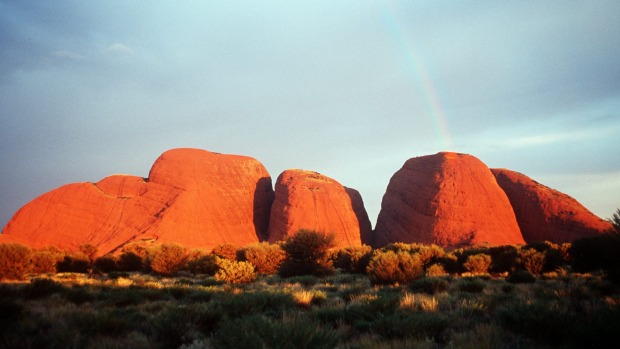
Everyone is watching Malya's finger. The Aboriginal artist sits cross-legged on the ground tracing shapes in the red dust and the assembled children watch closely and hang on his every softly spoken word. The symbols he draws – a dingo footprint, people sitting down, concentric circles to represent a meeting place – speak of relationships, of storytelling, of eons. Malya Teamay is an artist of renown here and his work Tjukurpa of Uluru was chosen to illustrate the National Park admission pass.
He proceeds to paint on a small canvass and an easy, unhurried flair flows from his brush and dot stick. Inspired, the kids paint their own stories and some real talent emerges. They take turns explaining the stories behind their paintings and each story is applauded by the other children. This is the essence of the AAT Kings Family Shindig tour of Uluru-Kata Tjuta – fun, fellowship and learning.
The new Shindig itinerary provides a fulsome exploration of the area in a friendly group environment. The AAT Kings bus has Wi-Fi but these "Gen-device" kids are getting connected to the red centre rather than their iStuff.
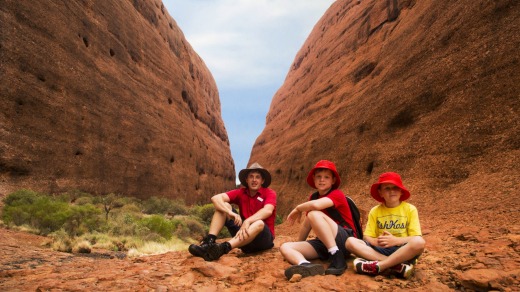
We begin with a late afternoon get-together under a tree at Yulara village in the Ayers Rock Resort, a collection of hotels and a "Town Centre" of restaurants, a supermarket, bank and post office. The children – aged from about three to 13 – receive a backpack, water bottle, educational workbook, stationery pack, sunscreen and a hat and are delighted with the merchandise.
The bus takes us out for our first look at the rock, over drinks and canapés at a designated evening viewing area that is packed with tourists. Selfie sticks are raised and cameras click feverishly as the light fades and Uluru puts on its legendary sunset colour change. They can click as much as they like but they will never capture the moment. You have to be here. Even in this crowd, it's atmospheric.
Of course the region is the star of the Shindig show but our guide, Delma Coulson, performs beautifully in the supporting role. We learn about the local Indigenous people, collectively known as Anangu and she teaches the kids to scream "Palya!" – the Anangu word for "g'day" – every time the bus passes the booth at the National Park entrance. Over four days, Delma weaves an engaging narrative of facts, figures, Anangu legends, European exploration, geology, biology, bush tucker, banter, singalongs and lame jokes. It's a brilliant performance, a skilled balancing act of edification and entertainment that – along with the itinerary – makes the tour.
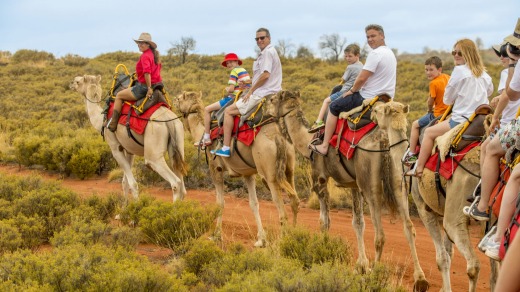
We're up early the next morning for a dawn viewing and Uluru turns it on again. The chill air that accompanies the first rays produces a visceral ambience. How many countless millions of sunrises have touched Uluru, just as we are seeing it today? How obvious that it be a sacred part of Indigenous lore.
A hearty breakfast of eggs and bacon and quite acceptable coffee at the nearby Cultural Centre's Ininti Cafe precedes the next adventure – a 400-metre walk to Mutitjulu waterhole at the base of the Rock, the home of Wanampi, an ancestral water snake. Delma tells the children they are surrounded by Aboriginal peoples' supermarket, hardware store and pharmacy, and explains how they used the surrounding plants. We see two artworks from the opposite ends of time – ancient petroglyphs beneath an overhang and an ironwood chair carved from debris from Cyclone Tracey. Wills and Kate apparently sat here for a photo op in 2014 so we pause as each child's bum reenacts the royal sitting.
This was also the site of the great battle between the snake spirits Kuniya and Liru and we sit on the rock and listen to Delma recount this defining Anangu Tjukurpa legend. (See separate box)
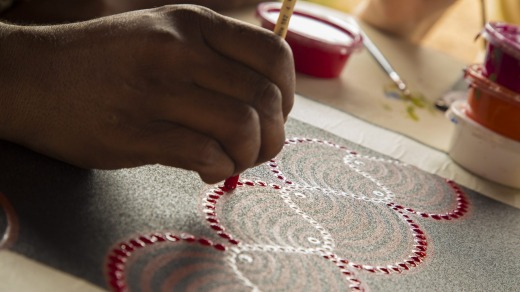
Travelling time between destinations on the very comfortable AAT Kings bus is filled with more stories and information. We learn how this desiccated land was an inland sea half a billion years ago before upheaval, tilting and erosion produced the current landscape. The kids are impressed that the rock, which reaches 348 metres above the ground, also extends six kilometres underground and is actually the tip of an inselberg, or island mountain.
There's more fun and laughter after lunch at the Cultural Centre as Ranger Rachel Ferguson takes over. She supervises a Pitjantjatjara language game of charades and one kid does his best emu impression that another youngster insists is an Egyptian. The kids learn a little about the local flora and fauna and a lot about the mala (a recently reintroduced hare-wallaby) and they burn off some energy with a game of "catch the mala". Rachel then sends them off on a treasure hunt for facts available within the Cultural Centre. Everyone wins and the prize is a few sheets of paper made from mala poo. Finally Rachel passes around a few jars of bush tucker and while the kids argue about the efficacy – and odours – they learn there is far more to the red centre than meets the untrained Caucasian eye. The naked woollybutt grass – used to make a type of damper – and how to survive by eating honey ants' bums are the kids' favourites. Rachel knows her audience.
Day three takes us to Kata Tjuta (The Olgas) and a pause at the Cattle Yards sand dune lookout provides a perspective-clarifying photo op of the distinctive mounds. A couple of walks of moderate exertion to the first lookout at the Valley of Winds and to the creek bed at Walpa Gorge provide stunning and divergent views. Walpa also gets a solid workout as the kids test their "cooee" echoes.
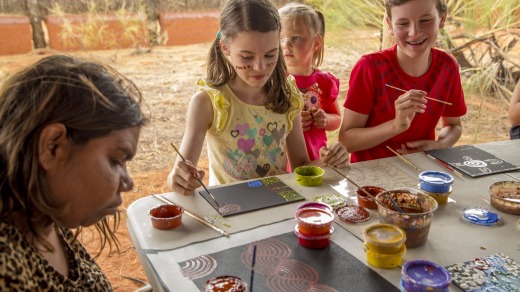
Uluru Camel Tours has been the most keenly anticipated stop on the itinerary and our phalanx of young cameleers love riding the doe-eyed beasts. On the 45-minute ride through the dunes we learn lots of dromedary data and hear the incredible story of camels in Australia, pausing briefly to snap camel-fies with Uluru in the background. The kids overfeed the resident emu and water buffalo and pester their parents for camel souvenirs from the gift shop.
Uluru-Kata Tjuta is certainly one of Australia's definitive adventures and the AAT Kings Shindig itinerary nails it. The bus picks us up and drops us off at our various hotels on time every day, meals and pit stops are frequent and there is barely a tantrum thrown on the entire trip.
On the last night we enjoy a white tablecloth barbecue dinner overlooking Uluru, along with 200 or so other AAT Kings tour guests. There are lots of Japanese and judging by the enthusiastic laughter they have had a good time too, even though they seem apprehensive about the kangaroo steaks. Wagyu 'roo anyone?
This part of Australia certainly has a soul. Whether it's the Aboriginal connection and artistic dignity or the timelessness of the natural monuments, a serene otherworldly spirit dwells in the wind and the dirt here. If you can just get the kids to stop singing The Wheels on the Bus for long enough to feel it.
Tjukurpa (pronounced chook-ur-pah) is a collective word for the culture, ethics, law, beliefs and traditions of the Anangu people. It is the cornerstone of the Indigenous Uluru-Kata Tjuta experience and you will get more from your visit if you learn about it. Tjukurpa is also the Anangu peoples' version of the Dreaming but it is more than just an abstract explanation of how the rocks and trees of the area came to be. Not all of it can be shared. Some of it is sacred.
One prominent Tjukurpa creation story – often told in art here – is the tale of Kaniya and Liru. One day, a group of Lirus (venomous snakes) ambushed a young Kuniya (woma python) boy and threw their spears at him so hard you can still see the holes they made in Uluru. They killed him and his aunt was so angry she chased the Lirus and killed one with a stick. The place where she slid in to the rock is represented by a dark wavy line on the rock and the blood that poured from the Liru's head wound is a red marking. The full account of the Kaniya-Liru encounter is much longer and the physical manifestations near the Mutitjulu waterhole at Uluru more detailed. The deeper you look, the more layered and intriguing is the Tjukurpa.
Tjukurpa stories and traditions are told with great heart at the Cultural Centre, which was designed to incorporate Kuniya into its shape.
aatkings.com/tours/uluru-family-shindig
Jetstar flies direct to Yulara (Ayers Rock Airport) from Sydney five days a week and from Melbourne four days a week. Virgin Australia flies direct from Sydney daily. You'll be met at the airport by your AAT Kings guide and transfers to and from the airport to your hotel are included.
AAT Kings four-day guided Uluru Shindig includes three nights' accommodation, some meals including breakfast daily, National Park entry fee and the camel ride. Children also receive a backpack, educational workbook, stationery pack, sunscreen, hat and water bottle.
Cost: From $837 per person twin share (based on two adults and two children). Guests can stay at Outback Pioneer Hotel (from $837 pp), Desert Garden Hotel (from $885 pp), Sails in the Desert (from $925 pp) or Emu Walks Apartments (from $929 pp).
2016 departure dates: 29 March, 12 April, 5 July and 27 September.
To book, visit aatkings.com or call 1300 228 546.